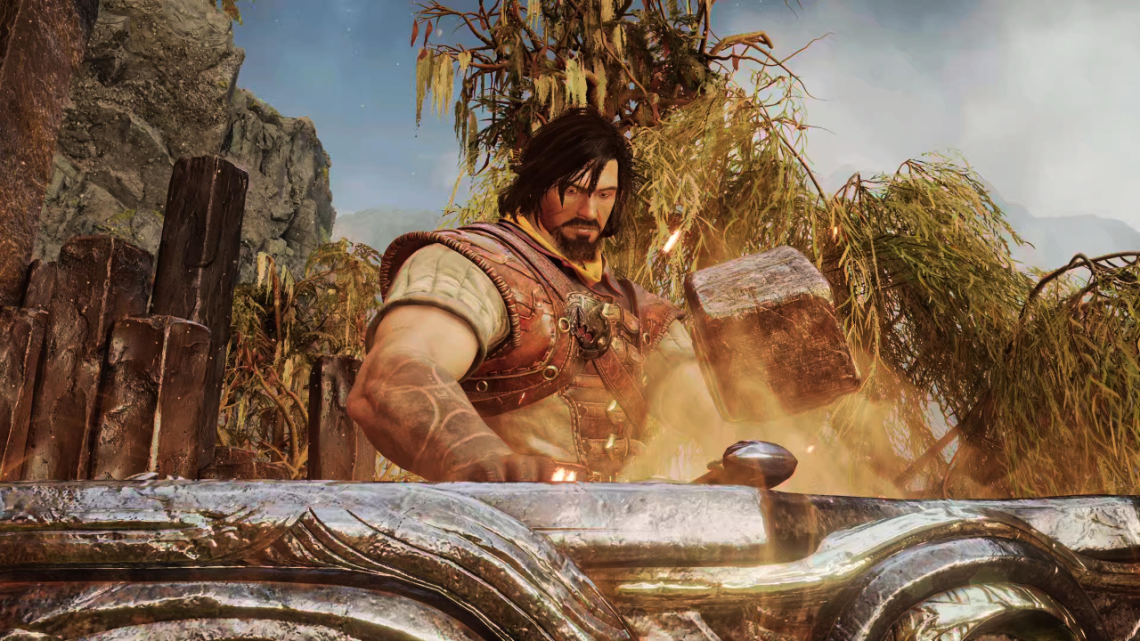I’ve gone into Blades of Fire knowing that I’m not the target demographic. Blades of Fire is an action-adventure game with a twist on souls-like combat. One that drew me in to play a game that I may have otherwise not been interested in.
The souls-like is not my favorite style of gameplay with my experience limited to mostly Elden Ring and Ghost of Tsushima. Souls-like games require patience in their combat, timing strikes, and mastering dodges and parries. It’s not something I find particularly easy, so I struggle to get into.
That being said, I have played Blades of Fire the same way I played Elden Ring — slow, tedious progress in which I died A LOT. At times, my progress was slow and frustrating, but despite the issues I had with many aspects of the game there is a charm at the heart of it.
Setting, World, and Story
In Blades of Fire you play as Aran, a blacksmith granted great power on a quest to kill The Queen. Aran is joined on this quest with a young companion called Adso who, though lacking the martial skill and strength of Aran, is well versed in history and magic providing Aran with the vital assistance he will need along the way.
The dynamic between Aran and Adso is one clearly modeled on Kratos and Atreus, but it often feels quite forced. Within the story, these characters have only just met but almost immediately have a father and son-esque relationship that doesn’t quite land. With a little more time to foster their relationship, it would work far better but given that they meet for the first time in the game’s opening it just seemed odd.
The story’s presentation often left me unsure as to what was actually going on. The overarching narrative of the game is focused around traversing the world in order to reach and kill the Queen, but each area has a story that feels entirely self-contained. The zones themselves are varied in design but there’s little connective tissue and the pacing of the zones feels uneven. In some areas I found myself circling again and again to uncover the missing step required to move on, while the next zone would be a clear path with little thought required to figure out what needed to be done.

The game doesn’t explicitly tell you what your current objective is, so a lot of time will be spent navigating the world to find the next trigger for the story. Sometimes, this is more guided but for the most part you are free to figure it out in your own way. If you are struggling there is an option to show where the next objective is, that can be accessed through the pause menu.
As the story’s presentation is often vague, Adso is intended to provide clues about your objective, information about your current area and the characters you have met. While these tidbits were interesting additions that made the world feel fleshed out, the information to guide you forward was often vague and generic to the overall goal of the zones, rather than tailored to your specific task. Though Adso and Aran’s discussion of the world and its lore is interesting, the world still feels abandoned as the only people you interact with are enemies and allies.
Combat
The first pillar of gameplay is combat, which is exactly what you might expect for a souls-like. Dodges and parries will be your bread and butter. The unique aspect of combat for Blades of Fire is that it comprises entirely of directional attacks.
On the PS5, Square, Triangle, Circle, and Cross will attack left, head, right, and body respectively and you will need to flow between the direction you swing your weapon and the strike type in order to ensure the maximum amount of damage. I found this system to be an interesting take on the combat, beyond the usual light attack, heavy attack, and ranged. Blades of Fire, unfortunately, doesn’t capitalize on the combat system to keep it engaging.
Every foe will be weak to a strike type such as blunt damage from a warhammer or piercing damage from a sword. Some weapons will only be able to do one type of damage, and other weapons will be able to switch between different types. When targeting an enemy, each part of their body will be highlighted in red, orange, or green. Green areas will take maximum damage from your weapon and strike type; orange areas are partially armored and might only take 40%-60% damage, and red areas will be heavily armored and receive <20%.

Enemies you face as essentially cannon fodder are fully highlighted in green, and any attack will take them out with ease. Additionally, heavy attacks can be made by holding down the attack button for that direction and have the ability to mutilate your foe which will lop off a body part when you kill them. This starts off as a cool way to take down enemies, with it being extremely satisfying to decapitate a foe in a single strike but, like rest of the combat, there isn’t enough variation.
After a while, combat had settled into a rhythm where weak enemies would be struck down in a single heavy strike with the engaging combat being against stronger enemies who require working around their attack pattern to get a strike in. Despite the rote nature of the combat, it did offer some challenge, partially due to my difficulty in mastering parrying in most games, opening myself up to more damage that I would otherwise be taking.
A few other aspects contributed to the game’s challenge. One is the difficulty level which will change parry timings for enemy attacks and increase damage done and received. I am a big advocate for games offering extensive difficulty modifiers to allow players to tailor difficulty to their playstyle and ability, so it was disappointing that Blades of Fire only featured traditional easy, medium and hard settings. I kept the game on Steel; the hardest and recommended difficulty and it was challenging but not too challenging.

However, this quickly changed when I entered the game’s second area of the Crimson Citadel. Here I encountered a harsh jump in difficulty. The area features a roaming mini-boss, an increase in enemy density and a maze-like structure of narrow corridors, and I spent many more hours stuck here than I suspect I was intended to.
The narrow spaces made dodging more difficult, fighting enemies and the camera to ensure I could see where I was dodging and not get stuck against a wall. In tight spaces and situations involving more than two enemies, the combat starts to severely falter. Switching between weapons and strikes mid-combat, while also attempting to dodge and block attacks from multiple angles, becomes cumbersome. In a large crowd attacks become ineffectual with target locks bouncing between enemies and attacks bouncing off enemies or off the environment itself.
I found myself up against a progress roadblock here for a long time, pushing me to just drop the difficulty so I could have an easier time navigating to just get through the area. Here, all of the worst aspects of the game came together for a brutally frustrating experience, to the point I questioned if I would even continue this review.
Crafting and Exploration
While combat is probably the biggest aspect of gameplay, crafting is definitely the most important. Every weapon you wield has been hand-crafted by you. The level of customization varies with more options unlocked through shrines commonly found in the world. You start off with a few basic designs and can earn new schematics by killing the enemies that wield them. When forging, you have a lot of options to tailor weapons to how you play, including blade length, and the type of steel to be used among more. Each option will contribute to the stats allowing you to balance between attack stats, defensive stats or durability stats.

Crafting ties to exploration in a way that makes both more compelling. Exploring will provide materials to use in crafting as you defeat enemies, shrines will unlock new options for weapons while chests include skill scrolls will allow you to be able to craft higher quality weapons or increase health. Weapon quality is important as this determines how many times you will be able to repair it before it permanently breaks.
When first crafting a weapon, you complete a forge minigame. In this minigame you strike metal segments of the blade to match the weapons shape. The closer you match it, the more stars you get, with a 5-star weapon repairable 5 times. The minigame takes a little getting used to. To get the segments in the right places you change the strength, size, and tilt of each strike you make, allowing you to control how the segments will move. I really enjoyed the minigame, it helped to sell the immersion of forging, created a stronger bond with the weapons made, while also making the weapon’s durability have a purpose, though there is a welcome feature to reuse your previous best minigame. Forging is a frequent occurrence as weapons break or are dropped out in the world when you die, with each new weapon representing a jump in quality and strength. The crafting in Blades of Fire is simple but has all the depth the combat lacks.

Most of the map is a series of narrow tunnels with open spaces you might encounter enemies in. The game promises a lot of freedom when it presents the world to you, although it’s quite linear and often frustrating when cues for where to go next aren’t as apparent as they need to be. Each area has different routes that can be used to navigate around, with unlockable shortcuts to make traversal quicker and anvils scattered around to fast travel, travel to the forge to craft weapons, repair and recycle weapons, or rest to replenish health and respawn enemies.
The linear nature of areas really hindered the experience of exploring the world. Once it became apparent, exploration started to feel far less rewarding, instead becoming an exercise in following all the routes to uncover everything rather than naturally finding things, more apparent by the lack of visible points of interest to guide your exploration.

Summary
I feel as though I’m in several minds about Blades of Fire. I can only approach this through my own experiences as a novice to the souls-like experience, and as a novice there are elements that I may not have as much patience with, or draw as much enjoyment from, as the seasoned player. That being said, kudos has to go out to Blades of Fire for having an interesting enough premise to draw in a potential convert and I did, for the most part, enjoy my time with Blades of Fire.
On offer here is an interesting story with engaging characters, simple, and gorgeous environments. There’s a charm to the writing and aesthetic that is reminiscent of Xbox 360/PS3 era games such as Fable and Brütal Legend, and a stunningly haunting soundtrack to accompany it all.
Where it is perhaps let down the most is the uneven pacing, characterization that can feel unnatural and unearned, and a simplistic combat system flawed enough to tip the balance from fun and challenging to frustration. Though I was enjoying the game, by the 25th hour of my playthrough the repetitive and frustrating combat was starting to take its toll, and I had about hit my limit. I’ll no doubt keep chipping away at Blades of Fire, but the uneven pacing and flawed combat has sucked much of the fun out of the game for me.
Blades of Fire is out now on PS5, Xbox Series X|S, and PC.
The Review
Fair








